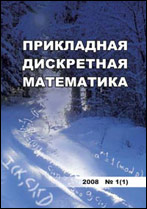|
Эта публикация цитируется в 10 научных статьях (всего в 10 статьях)
Математические методы криптографии
Asymmetric cryptosystems on Boolean functions
G. P. Agibalov, I. A. Pankratova
National Research Tomsk State University, Tomsk, Russia
Аннотация:
Here, we define an asymmetric substitution cryptosystem combining both a public key cipher and a signature scheme with the functional keys. A public key in the cryptosystem is a vector Boolean function $f(x_1,\dots,x_n)$ of a dimension $n$. This function is obtained by permutation and negation operations on variables and coordinate functions of a bijective vector Boolean function $g(x_1,\dots,x_n)=(g_1(x_1,\dots,x_n),\dots,g_n(x_1,\dots,x_n))$. The function $g$ is called a generating function of the cryptosystem. For each $i\in\{1,\dots,n\}$, its coordinate function $g_i(x_1,\dots,x_n)$ is assumed to be specified in a constructive way and to have a polynomial (in $n$) complexity. A private key of the cryptosystem is the function $f^{-1}$, that is, the inverse of $f$. The existence of $f^{-1}$ follows from the bijectiveness of $g$ and preserving this property by permutation and negation operations. Function $g$ and its coordinates $g_1,\dots,g_n$ are public parameters of the cryptosystem. (A variant of the cryptosystem allows to include them into the private key). Of course, the permutation and negation operations by which a public key is computed from the generating function must be secret as private exponents in RSA and ElGamal cryptosystems. A block $P$ of a plaintext is encrypted to a block $C$ of a ciphertext by the rule $C=f(P)$, and $C$ is decrypted to $P$ by the rule $P=f^{-1}(C)$. A signature on a message $M$ is computed as $S = f^{-1}(P)$, and its validation is proved by verifying the equality $M=f(S)$. This cryptosystem is believed to resist classical and quantum computers attacks. Its security is based on the difficulty of inverting large bijective vector Boolean functions. Cryptanalysis of the cryptosystem shows that its computational complexity can reach the value O$(n!2^n)$.
Ключевые слова:
vector Boolean functions, invertibility, asymmetric substitution cryptosystem, cryptanalysis.
Образец цитирования:
G. P. Agibalov, I. A. Pankratova, “Asymmetric cryptosystems on Boolean functions”, ПДМ, 2018, no. 40, 23–33
Образцы ссылок на эту страницу:
https://www.mathnet.ru/rus/pdm618 https://www.mathnet.ru/rus/pdm/y2018/i2/p23
|

|




 Обратная связь:
Обратная связь: Пользовательское соглашение
Пользовательское соглашение
 Регистрация посетителей портала
Регистрация посетителей портала Логотипы
Логотипы








 Цитирование в формате
Цитирование в формате 
